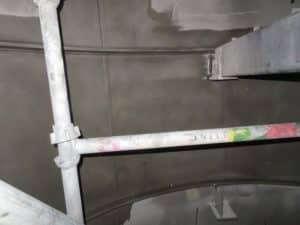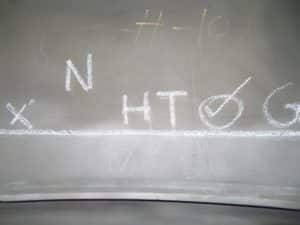CO2 Corrosion Mitigation in a Regenerator Column at LNG Plant
CO2 Corrosion Mitigation by On-Site Alloy Upgrade during Turnaround
This case study describes the mitigation of CO2-induced regenerator column corrosion at an LNG plant. The plant had previously tried unsuccessfully to protect the area with conventional thermal spray. Now, IGS has removed failed third-party coating and installed the HVTS alloy upgrade.
Problem
An LNG plant required a solution to prevent CO2 corrosion attack in a regenerator column caused by a highly corrosive feedstock. A previous application of conventional thermal spray coating had led to failures, so the plant required an urgent response to repair the damaged thermal spray coating during the upcoming turnaround. Just 10 days after being instructed, IGS had mobilised a team to be ready onsite at the plant.
The Inspection
Upon mobilization of IGS material, equipment, and personnel resources in September 2022, a thorough inspection was carried out by IGS and the plant’s inspection team of the conventional thermal spray coating applied by a third-party provider in April 2018. The inspection found numerous coating failures across the upper and lower chambers with visible micro-cracking and blistering apparent.
What is CO2 Corrosion?
CO2 corrosion is a form of degradation that occurs when dissolved CO2 in condensate forms carbonic acid (H2CO3), which corrodes steels and low alloys to form an iron carbonate scale.
The IGS Solution
IGS removed the failed thermal spray coating in regions with micro-cracking, blistering, spalls, and delamination. Once completed, the shell substrate surface condition was inspected, and surface preparation was carried out by IGS technicians. Once the surface was prepared correctly, IGS applied its own uniquely developed High Velocity Thermal Spray (HVTS) cladding, with more than 40m² of IGS HVTS cladding applied onsite, on time and at the highest quality standard.
The Results
A conventional thermal spray contractor was initially chosen in 2018. Conventional thermal spray coating providers use standard material, low-velocity process technology, and non-specialized and inexperienced workforces, factors that led to failures in this column. The cost of thermal spray coating failure is not limited to the cost of thermal spray coating repair or replacement, but extends to the need for mechanical repair, prolonging outage/turnaround time (equals loss of production time), and even risk of loss of containment.
IGS was able to restore this column’s integrity for the client and will be contracted to provide HVTS services in other amine columns in the future. IGS has been providing the in-situ applied HVTS technology for permanent corrosion mitigation in
amine process equipment for 30+ years with proven performance in the world’s largest oil and gas companies.


HVTS cladding applied on internal shell
Download a PDF version of this case study
More Corrosion Prevention Case Studies from IGS:
Preventing Wet CO₂ Corrosion in Carbon Capture and Storage Project
Free consultation with an IGS Subject Matter Expert
IGS is here to provide information, answer questions and create an effective solution for your needs.

